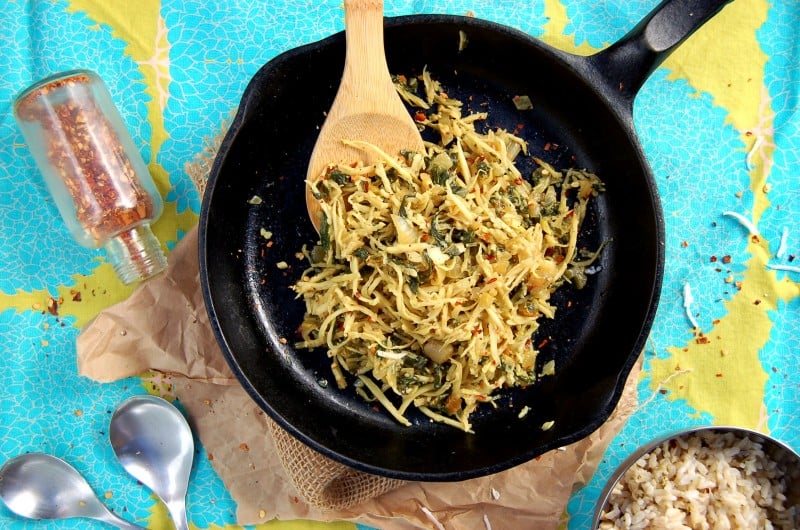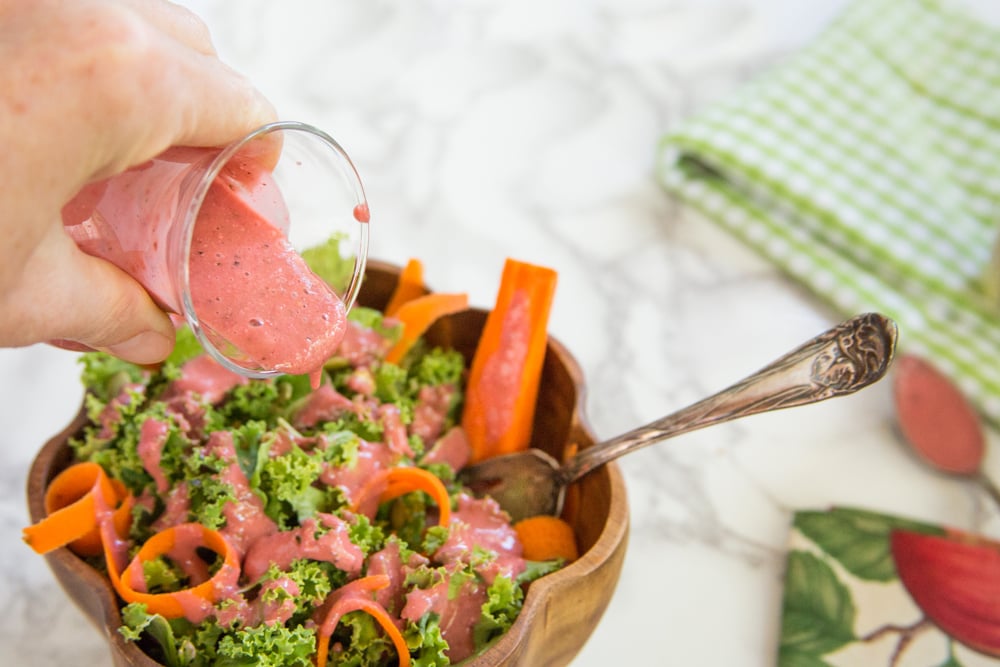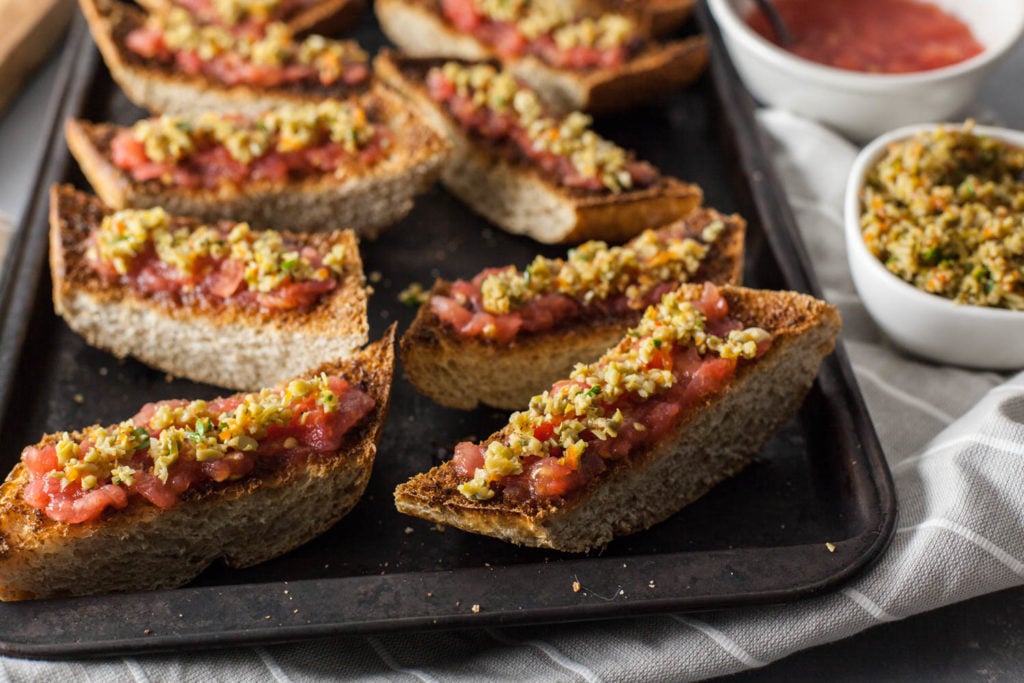Top 10 Minimally Processed Plant Foods and What to Do with Them + Instant Pot Biryani Rice

By Molly Patrick
Aug 30, 2016,
People tend to over-complicate shit, especially when it comes to eating lots of plants.
When you switch to eating a Whole Food Plant Based diet, there are six categories of food that you’ll eat from:
- Veggies
- Fruit
- Beans and Legumes
- Whole Grains
- Nuts and Seeds
- Minimally processed plant foods made with ingredients from the above five categories.
Easy enough.
Next up. There are two categories of food that you’ll eliminate when boarding the Whole Food Plant Based train (don’t worry, you can exit the train any time. It’ll even stop for you so you don’t have to jump off mid-journey and get punched by the ground).
The foods that won’t be making an appearance while on this train are:
- Animal based foods
- Processed foods (vegan or not)
People are generally familiar with veggies, fruit, beans and legumes, whole grains and nuts and seeds. Minimally processed plant foods on the other hand can be a little like the hair on the uppermost part of my thigh – is it meant to be leg hair or pubic hair? Who really knows. It’s confusing.
I might not know what category my hair wants to be in, but I do know all about minimally processed plant foods. And after today’s Fuckery, you will too.
Top 10 Minimally Processed Plant Foods:
1. Tahini
2. Coconut Aminos
3. Sprouted bread
4. Sprouted corn tortillas
5. Tofu
6. Almond butter
7. Sauerkraut
8. Brown Rice Vinegar
9. Non-dairy milk
10. Soy Sauce
I’ve taken the above list of the most important minimally processed plant foods and I’ve answered the following questions about each:
- What is it?
- Where can I find it?
- How do I store it?
- What do I do with it?
- Is it gluten free?
- Is there anything else that I should know about it?
There are of course more than ten minimally processed plant foods that are A-Okay to add into a Whole Food Plant Based diet – there are about 30 that I use. But these are the ten that I use most often. If you get my weekly Plant Fueled Meal Plans, then you already have most of these ingredients in your kitchen – now they’ll make more sense to you.
The reason these foods have the green light when eating a Whole Food Plant Based diet is because they haven’t been processed to the point of having their nutrients and fiber stripped away. Basically, even though they’ve been slightly modified from their original form, they still have important nutrients that your beautiful body needs.
Okay! Onward.
1. TAHINI
What is it?
Tahini is ground sesame seeds. It’s kind of like peanut butter, but made with sesame seeds instead of peanuts.
Where can I find it?
You can find it at any ethnic grocery store or in the nut butter section at any health food store.
How do I store it?
Store it in the fridge after you open it.
What do I do with it?
Tahini is a crucial ingredient in hummus as well as all kinds of Whole Food Plant Based sauces and dressings, including our famous T-Crack.
Is it gluten free?
Yup.
Is there anything else I should know about it?
Tahini made from unhulled sesame seeds has more nutrients and fiber than tahini that’s made with hulled sesame seeds. This is because it’s made from the whole sesame seed. Unfortunately, this type of tahini has a bitter tinge that most people can’t get past. If you can’t get with the bitter taste of tahini, make sure you buy tahini made from hulled sesame seeds, not unhulled.
2. COCONUT AMINOS
What is it?
Coconut Aminos is a sauce made from coconut sap and sea salt. It’s dark, rich, salty and slightly sweet. The sweet flavor is what makes it totally unique and hard to substitute with any other ingredient. The closest substitution that I can think of is to blend soy sauce with a soft date and a little water. It would be much easier just to buy a bottle of Coconut Aminos and be done with it.
Where can I find it?
You can find it in the Asian section of most any health food store, next to the soy sauce.
How do I store it?
Store it in the fridge after you open it.
What do I do with it?
SO many things! If you get my meal plans, you know how often I use it and how versatile it is. One of my fave things to do with it is to shake a little over some steamed broccoli and top with sesame seeds. It’s surprisingly delicious for how simple it sounds.
Is it gluten free?
Yup.
Is there anything else I should know about it?
Coconut Aminos are a little pricy, but a bottle will last you a while and it is worth EVERY penny. It’s less than a bottle of wine and you’ll have it for MUCH longer.
Adding just a little sweetness can make a huge delicious difference in many savory dishes.
If you have a recipe for a savory dish that calls for sugar, use some Coconut Aminos instead. The natural sweetness will give it the perfect pop of sweet.
3. SPROUTED BREAD
What is it?
Sprouted bread is made from whole grains that’ve been sprouted and then ground. This process not only retains nutrients and fiber, but it also increases the nutrients availability to our bods.
Where can I find it?
You can find it in the freezer section at any health food store. Regular grocery stores are also starting to carry it, also in the freezer section.
How do I store it?
Store it in the fridge. You can also store it in your freezer and it will last for a crazy long time.
What do I do with it?
Sandwiches! I also freeze the ends of my bread and make a batch of croutons when I have enough.
Is it gluten free?
Most are not gluten free, but the company Food For Life has gluten free varieties.
Is there anything else I should know about it?
Most people who have a hard time digesting gluten have no problem digesting sprouted grain bread. If you have a true gluten sensitivity, stick to the gluten free variety.
My favorite brand of sprouted grain bread is Food for Life. They have lots of different flavors to choose from.
Silver Hills and Dave’s Killer bread are yummy, but they do contain some sugar. Food For Life, contains no sugar.
4. SPROUTED CORN TORTILLAS
What is it?
Sprouted corn tortillas are made with just a few ingredients – sprouted corn, water, salt and lime. Just like sprouted bread, the nutrients are retained and the availability increased through the sprouting process.
Where can I find it?
Look for them in the freezer section at your health food store.
How do I store it?
Store them in the fridge. If you want them to keep for longer, store them in your freezer.
I usually freeze half and put half in my fridge.
What do I do with them?
Tacos. Tacos. Tacos.
The ingredient and filling options are endless. One of my favorite lunches is to heat up a couple sprouted corn tortillas, slap some hummus on them, add some diced cucumbers, shredded carrots, chopped kale and some baked tofu strips and chow down. It’s an unbelievably satisfying lunch in under 5 minutes.
Is it gluten free?
Food for Life Sprouted Corn Tortillas are gluten free.
Is there anything else I should know about it?
Food For Life is the only brand that offers sprouted corn tortillas that I know of.
5. TOFU
What is it?
First up – tofu is boss.
Secondly, tofu is made by curdling fresh soy milk, pressing it into a solid block and letting it cool. It is similar to how dairy cheese is made by curdling and solidifying dairy milk.
Where can I find it?
Tofu can be found in the refrigerated section at any health food store or in the produce section at most traditional grocery stores.
How do I store it?
Tofu should always be stored in the fridge.
What do I do with it?
Tofu by itself is bland, so you really have to incorporate other yummy ingredients, especially herbs and spices when preparing it.
My fave ways to use tofu are baked and in veggie stir fry.
Is it gluten free?
Yup.
Is there anything else I should know about it?
As a rule of thumb, you can assume that soybeans have been genetically modified if they’re not organic. Choose a brand of tofu that is either certified organic or has the Non-GMO Project Verified blue and green seal on it.
Stick to firm or extra firm tofu for cooking. If you’re using tofu to sub dairy in baked goods, silken tofu works best. Silken tofu is not found in the refrigerated section, it is on the shelves by the baking ingredients.
6. ALMOND BUTTER
What is it?
Almond butter is made out of ground almonds. Think peanut butter but made with almonds instead of peanuts.
Where can I find it?
You can find almond butter with the rest of the nut butters at your health food store. You can also sometimes find it in the bulk section where you can grind it yourself and buy it by the pound.
How do I store it?
Store it in the fridge.
What do I do with it?
Spread it on sprouted grain toast and top it with berries, add it to your smoothies, make sauces with it and stuff it into dried dates when your sweet tooth hits – start with these and you’ll quickly see why it’s a WFPB staple.
Is it gluten free?
Yup.
Is there anything else I should know about it?
Some brands of almond butter add oil, salt and / or sugar.
Make sure you choose an almond butter with one ingredient – almonds.
7. SAUERKRAUT
What is it?
Sauerkraut is fermented cabbage.
Where can I find it?
You can find sauerkraut in the refrigerated section at any health food store. You can also find varieties by the pickles on dry shelves at the grocery store. Ethnic grocery stores also have decent quality sauerkraut. See note below about choosing your sauerkraut.
How do I store it?
Store it in the fridge.
What do I do with it?
Add it to salads, sandwiches and wraps.
Is it gluten free?
Yup.
Is there anything else I should know about it?
Make sure to buy sauerkraut without vinegar. The awesome thing about sauerkraut is that it’s a fermented food and fermented foods help balance the gut. When vinegar is introduced, it kills off the beneficial bacteria and it goes from being a fermented food to a pickled food.
Let that good bacteria work its magic and stay away from sauerkraut with vinegar.
Bubbies is my favorite brand of sauerkraut without vinegar.
8. BROWN RICE VINEGAR
What is it?
Rice vinegar is made from fermented rice. It’s generally less acidic than other vinegars and has a milder, sweeter flavor.
Where can I find it?
You can usually find rice vinegar along with the rest of the vinegars.
If you don’t see it, look in the Asian section.
How do I store it?
Store it in a cool dark place, like your pantry. There is no need to refrigerate any type of vinegar, even after it’s opened.
What do I do with it?
The sweet tinge and tame bite of rice vinegar is perfect for sauces, dressings, marinades and veggies. It pairs perfectly with soy sauce, garlic and ginger.
Is it gluten free?
Yup.
Is there anything else I should know about it?
There are many types of rice vinegar. White rice vinegar, black rice vinegar, seasoned rice vinegar, etc. Each one will have a unique flavor, but it’s generally okay to swap out different rice vinegars for others. I recommend brown rice vinegar because it has more nutrients. I do not recommend seasoned rice vinegar because most brands add sugar and even MSG.
9. NON-DAIRY MILK
What is it?
Non-dairy milk is milk that comes from plants instead of from animals.
Where can I find it?
Most traditional grocery stores and all health food stores will have a big selection of non-dairy milk, both in the refrigerated section and on the dry shelves.
How do I store it?
If you buy non-dairy milk from the refrigerated section, store it in your fridge as soon as you get home. If you buy the boxed kind of non-dairy milk from the regular dry shelves, you can store it in your pantry until you open it. Once it’s open it needs to be stored in your fridge.
What do I do with it?
You would use it the same exact way you would use regular dairy milk – in all its applications.
Is it gluten free?
Most are, but check the ingredients to make sure because brands differ.
Is there anything else I should know about it?
There are a shit ton of non-dairy milks to choose from; soy, almond, hemp, oat, rice, etc. Pick one with the fewest and easiest to pronounce ingredients, without any added sugar or oil (weird, right? I know). Some varieties have a crazy amount of ingredients that just aren’t necessary.
The only non-dairy milk I buy is Westsoy Original Unsweetened Soy Milk, or Trader Joe’s brand Unsweetened Plain Soy Milk. These are the only ones I’ve found that have just two ingredients, organic soy beans and water. If I want something else, like almond milk, I’ll make my own.
That said, ANY non-dairy milk is healthier than cow’s milk, so if you’re just transitioning to eating plant based, experiment with all the different types of plant based milk and see what you like best.
10. SOY SAUCE
What is it?
Soy sauce is a salty liquid made from fermented soybeans, wheat, water and salt.
There are wheat free varieties also available.
Where can I find it?
You can find soy sauce in the Asian section at any grocery store.
How do I store it?
Store it in your pantry. There’s no need to refrigerate soy sauce, even after it’s opened.
What do I do with it?
Use it in sauces, dressing and marinades. Use it to flavor soups, veggies and stir-frys.
Is it gluten free?
If you can’t have gluten, there are brands that offer gluten free soy sauce. Make sure you buy a variety that specifically states that it is gluten free.
Is there anything else I should know about it?
There are many different types of soy sauce. Some are high quality, some are cheap and full of gross ingredients. Make sure you check the ingredient label to make sure it doesn’t have anything funky added, like caramel color or corn syrup. My favorite brand is San-J.
Tamari and Shoyu are two types of soy sauce. Tamari is typically gluten free.
I hope that this clears things up!
If you ever have questions about these ingredients, hit me up in the comments below or ask over in the BEST private Facebook group ever.
Today’s recipe in two words: Flava Flave.

Ingredients
- ¼ cup red onion diced (30g
- 1 garlic clove minced
- 1 teaspoon cumin seeds
- ½ teaspoon turmeric powder
- ¼ teaspoon salt
- 1 cinnamon stick
- 1 cup brown rice 190g
- 1 ½ cups water 295ml
- ¼ cup raisins 35g
- ¼ cup tightly packed mint 5g, chopped
- Chopped raw cashew for garnish
Instructions
- Soak the rice in water for at least 10 minutes and then transfer to a fine mesh strainer. Run some new water through the rice to rinse it and then tap the strainer on the sink to extract as much excess water as possible. Set aside for now.
- Press the "saute" setting on your Instant Pot and let it heat up for about two minutes. Add the onion, garlic, cumin seeds, turmeric, salt and cinnamon stick to the Instant Pot and saute for one minute, stirring frequently so nothing sticks to the pot.
- Turn the Instant Pot off and add the rice and the water and stir. Press the “multigrain” setting and set the timer for 25 minutes.
- When the timer goes off, use the quick release method and take the lid off the pot. Add the raisins and the mint and stir.
- Top with raw chopped cashews and fresh mint leaves when serving.












Wishing you a happy week. May it be filled with not over-complicating shit.
xo
Molly
5 Comments
Leave a Comment
Love the food that loves you back
Get instant access to thousands of plant based recipes and meal plans, no credit card or perfection required.













Does this have a strong mint taste?
If I don’t have any cinnamon sticks, is there a rough amount of ground cinnamon that could be used in it’s place?
Hi Cassie, I just did a quick Google search and this site suggests that a “1 -3″ stick = 1/2 teaspoon ground cinnamon”. Hope that helps. Thanks for stopping by! ~Karen
Molly,
Are these free recipes (the ones in your blog) available in a book? I know that defeats the purpose of a “free” recipe, but I would be willing to buy a book (especially if it had pictures). I am starting my sixth week on the meal plan and some mornings I wake up crying because I feel so good. I just want MORE of your delicious recipes in a handy book. (My printer doesn’t like me, so I have to be sneaky and print from work. Shh… LOL)
I am enjoying the information you have in all your blogs and I’m learning so much on this journey. Thank you SO much!
Carole in Tallahassee, FL
Hi Carole, Thanks for being a Meal Plan subscriber! So glad you are loving the food. If you log into your classroom and head to Products & Guides, there are three recipe compilations for sale at this time. They are just select blog recipes, though, and not a book containing all of them. ~Karen